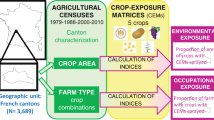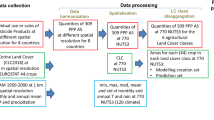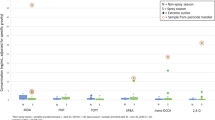Abstract
Organophosphorous insecticides (OPs) are the most commonly used insecticides in US agriculture, but little information is available regarding specific OP use by individual farmers. We describe OP use for licensed private pesticide applicators from Iowa and North Carolina in the Agricultural Health Study (AHS) using lifetime pesticide use data from 701 randomly selected male participants collected at three time periods. Of 27 OPs studied, 20 were used by >1%. Overall, 95% had ever applied at least one OP. The median number of different OPs used was 4 (maximum=13). Malathion was the most commonly used OP (74%) followed by chlorpyrifos (54%). OP use declined over time. At the first interview (1993–1997), 68% of participants had applied OPs in the past year; by the last interview (2005–2007), only 42% had. Similarly, median annual application days of OPs declined from 13.5 to 6 days. Although OP use was common, the specific OPs used varied by state, time period, and individual. Much of the variability in OP use was associated with the choice of OP, rather than the frequency or duration of application. Information on farmers’ OP use enhances our ability to characterize and understand the potential health effects of multiple OP exposures.
This is a preview of subscription content, access via your institution
Access options
Subscribe to this journal
Receive 6 print issues and online access
$259.00 per year
only $43.17 per issue
Buy this article
- Purchase on Springer Link
- Instant access to full article PDF
Prices may be subject to local taxes which are calculated during checkout




Similar content being viewed by others
References
United States Environmental Protection Agency (USEPA). Pesticide Industry Sales and Usage: 2006 and 2007 Market Estimates. Office of Pesticide Programs, US EPA, Washington, DC, 2011.
National Agricultural Statistics Service (NASS). Agricultural Chemical Use Database. http://www.pestmanagement.info/nass/app_usage.cfm, 2011. Accessed on 8 August 2011.
Gianessi L, and Reigner N. Pesticide Use in the U.S. Crop Production: 2002. CropLife Foundation, Crop Protection Research Institute, Washington, DC, 2006.
California Department of Pesticide Registration (CDPR). Pesticide Use Reporting. http://www.cdpr.ca.gov/docs/pur/purmain.htm, 2011. Accessed on 8 October 2011.
United States Environmental Protection Agency (USEPA). Organophosphorus Cumulative Risk Assessment—2006 Update. Office of Pesticide Programs, USEPA, Washington, DC, 2006.
Hodgson E, and Rose RL. Organophosphorus chemicals: potent inhibitors of the human metabolism of steroid hormones and xenobiotics. Drug metab Rev 2006: 38 (1–2): 149–162.
Mena S, Ortega A, and Estrela JM. Oxidative stress in environmental-induced carcinogenesis. Mutat Res 2009: 674 (1–2): 36–44.
Proskocil BJ, Bruun DA, Lorton JK, Blensly KC, Jacoby DB, Lein PJ, et al. Antigen sensitization influences organophosphorus pesticide-induced airway hyperreactivity. Environ Health Perspect 2008: 116 (3): 381–388.
United States Environmental Protection Agency (USEPA). Organophosphate Pesticides: Revised Cumulative Risk Assessment. Office of Pesticide Programs, USEPA, Washington, DC, 2002.
Barr DB, Bravo R, Weerasekera G, Caltabiano LM, Whitehead Jr RD, Olsson AO, et al. Concentrations of dialkyl phosphate metabolites of organophosphorus pesticides in the U.S. population. Environ Health Perspect 2004: 112 (2): 186–200.
Alavanja MC, Sandler DP, McMaster SB, Zahm SH, McDonnell CJ, Lynch CF, et al. The Agricultural Health Study. Environ Health Perspect 1996: 104 (4): 362–369.
Starks SE, Gerr F, Kamel F, Lynch CF, Jones MP, Alavanja MC, et al. Neurobehavioral function and organophosphate insecticide use among pesticide applicators in the Agricultural Health Study. Neurotoxicol Teratol 2012: 34 (1): 168–176.
Wood A. Compendium of Pesticide Common Names. http://www.alanwood.net/pesticides/index.html, 2011. Accessed on 8 August 2011.
Tarone RE, Alavanja MC, Zahm SH, Lubin JH, Sandler DP, McMaster SB, et al. The Agricultural Health Study: factors affecting completion and return of self-administered questionnaires in a large prospective cohort study of pesticide applicators. Am J Ind Med 1997: 31 (2): 233–242.
Blair A, and Zahm SH. Patterns of pesticide use among farmers: implications for epidemiologic research. Epidemiology 1993: 4 (1): 55–62.
Blair A, Tarone RE, Sandler D, Lynch CF, Rowland A, Wintersteen W, et al. Reliability of reporting on lifestyle and agricultural factors by a sample of participants in the Agricultural Health Study from Iowa. Epidemiology 2002: 13: 94–99.
Hoppin JA, Yucel F, Dosemeci M, and Sandler DP. Accuracy of self-reported pesticide use duration information from licensed pesticide applicators in the Agricultural Health Study. J Expo Anal Environ Epidemiol 2002: 12 (5): 313–318.
Acknowledgements
We thank Dr. Joe Coble for his efforts to create the AHS pesticide use data base. This work was supported by the intramural research program of the National Institutes of Health, the National Institute of Environmental Health Sciences (Z01-ES049030), National Cancer Institute (Z01-CP010119), and the National Institute for Occupational Safety and Health. The United States Environmental Protection Agency through its Office of Research and Development collaborated in the research described here; it has been subjected to Agency review and approved for publication.
Disclaimer
The findings and conclusions in this report are those of the authors and do not necessarily reflect the views of the National Institute for Occupational Safety and Health and Health Canada.
Author information
Authors and Affiliations
Corresponding author
Ethics declarations
Competing interests
The authors declare no conflict of interest.
Additional information
Supplementary Information accompanies the paper on the Journal of Exposure Science and Environmental Epidemiology website
Supplementary information
Rights and permissions
About this article
Cite this article
Hoppin, J., Long, S., Umbach, D. et al. Lifetime organophosphorous insecticide use among private pesticide applicators in the Agricultural Health Study. J Expo Sci Environ Epidemiol 22, 584–592 (2012). https://doi.org/10.1038/jes.2012.79
Received:
Accepted:
Published:
Issue Date:
DOI: https://doi.org/10.1038/jes.2012.79
Keywords
This article is cited by
-
Organic solvent exposure and depressive symptoms among licensed pesticide applicators in the Agricultural Health Study
International Archives of Occupational and Environmental Health (2017)



